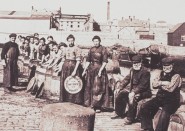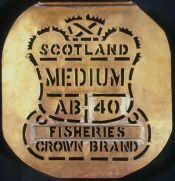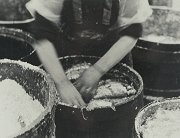Herring Home | Sale and Processing of herring | Next
Workforce of women - gutting and packing

By the latter part of the 19th century women played a major part in the herring industry. They were employed in the curing yards as gutters and packers. The women worked in teams or crews of three: two to gut and one to pack and the curer employed one team for every boat he engaged.
Gutting
The herring catches were unloaded into long wooden troughs called farlans, at which the gutters stood. The fish were gutted with a single movement of a sharp knife: this involved slitting the throat and removing the gills and gut. Sometimes they were sprinkled with salt to make them less slippery to handle. Most women were able to gut around 40 herring a minute, with some doing up to 60. The fish were then dropped into different containers depending on their size, and any that were broken or unsatisfactory were discarded. The guts were thrown into a gut cog, which was emptied into a barrel when full. Farmers collected the guts to use as fertilizers on their fields.
Sorting

Scottish cured herring developed a reputation for being of very high quality. One of the ways this was achieved was through sorting the fish. After gutting, the herring gutters sorted the fish according to size and condition. Size and quality of herring varied with the age of the fish and the season of the year. The best quality herring were known as matties. These were fat fish, in fine condition that had not yet developed roe. Adult herring that were ready to spawn were called 'fulls' and 'large fulls' ('fulls' meant that the fish had developed their roe). Herring that had already spawned were called 'spents', and these were the least valuable.
Packing

Once the tubs of gutted and sorted fish were full, the packers took over. The tubs were emptied into a rousing tub where salt was added. The fish and brine (very salty water) were then mixed or roused together. Next, the fish were then packed into barrels – this was a skilled job. The fish were arranged in a rosette pattern with the heads pointing outward in the first layer, and in the next layer this arrangement was reversed. As the barrel was filled, thick layers of coarse salt were thrown in to stop the layers of fish from touching each other. Five or six tons of salt was used for 100 crans of herring. The barrels held a cran or about 1000 herring and a good team could fill a barrel every 10 minutes. Once full, the barrels were left to stand for several days .